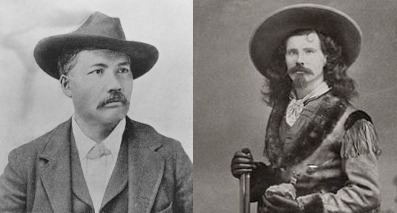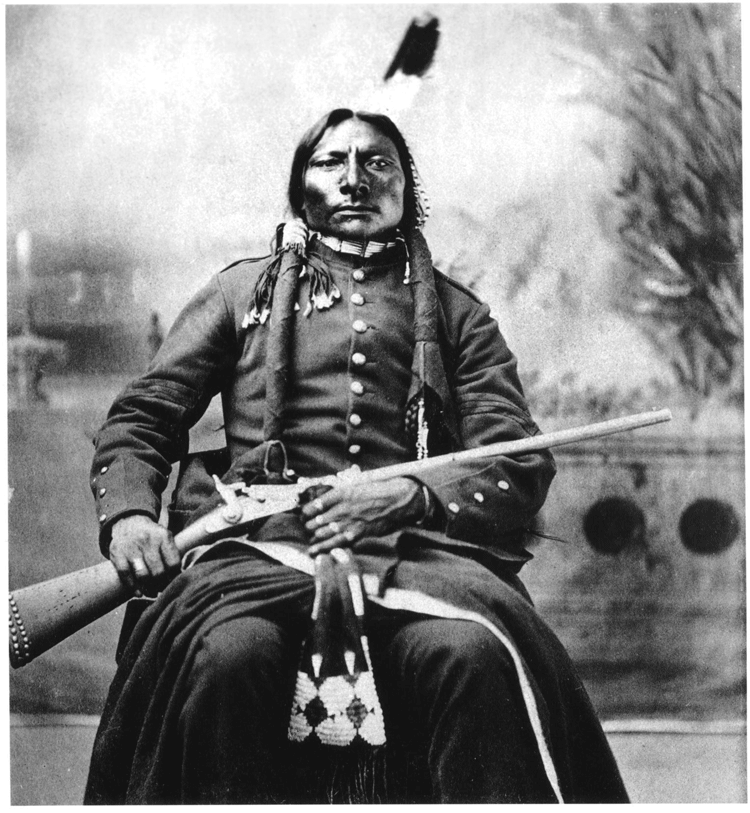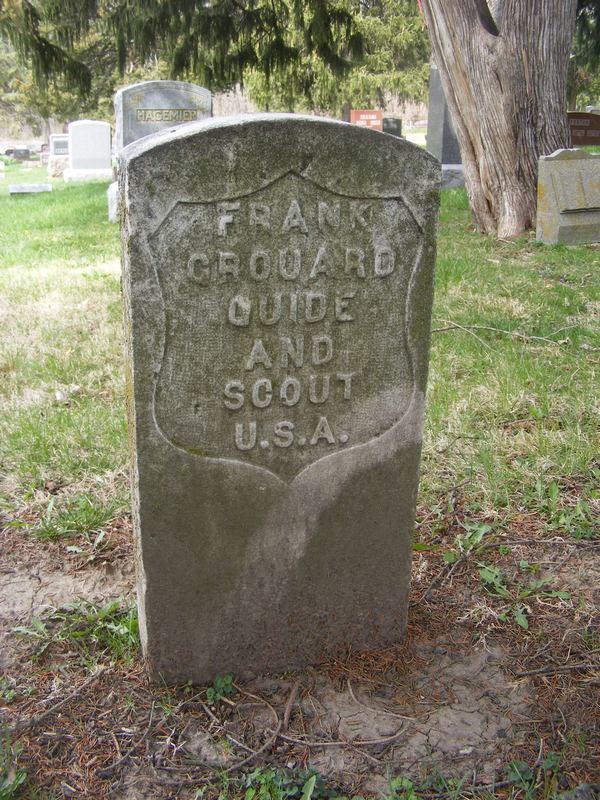Rank Chief Scout Unit 7th Cavalry Regiment | Name Frank Grouard | |
 | ||
Buried at Ashland Cemetery, St. Joseph, Buchanan County, Missouri, United States Battles/wars Indian WarsBig Horn ExpeditionBattle of Powder RiverBattle of the RosebudLittle Bighorn CampaignBattle of the RosebudBattle of Slim ButtesWounded Knee Massacre Died August 15, 1905, St. Louis, Missouri, United States Place of burial Saint Joseph, Missouri, United States Battles and wars | ||
Allegiance United States of America | ||
Frank Grouard (also known as Frank Gruard) (20 September 1850 – 15 August 1905) was a Scout and interpreter for General George Crook during the American Indian War of 1876.
Contents

Early years

Grouard's origins are the center of much speculation and controversy. He is variously described as having been American Indian, half-Indian, French-Creole or half-Black, the son of the early Black American Fur Company mountain man, John Brazeau. Grouard himself, in his biography dictated to journalist Joseph DeBarthe in 1891, stated he was born in the Society Islands in the south Pacific Ocean, the second of three sons born to Benjamin Franklin Grouard, an American Mormon missionary, and a Polynesian woman.

He moved to Utah with his parents and two brothers in 1852, later moving to San Bernardino in California. After a year in California, Grouard's wife returned to the South Pacific with two of the children, leaving Benjamin with the middle son, Frank. In 1855 he was adopted into the family of Addison and Louisa Barnes Pratt, fellow Mormon missionaries of his father. Grouard moved with the Pratt family to Beaver, Utah, from where he ran away at age 15, moving to Helena, Montana and becoming an express rider and stage driver.
Indian Scout
In about 1869, while working as a mail carrier, Grouard was captured near the mouth of the Milk River in Montana by Crow Indians who took all his possessions and abandoned him in a forest where he was found by Sioux Indians and later adopted as a brother by Chief Sitting Bull. He was probably accepted by them as an Indian because his Polynesian features resembled those of the Sioux. Grouard married a Sioux woman and learned to speak the Sioux language fluently, taking the Indian names 'Sitting-with-Upraised-Hands' and 'Standing Bear', (Yugata), as he had been captured wearing a bearskin coat. For seven to eight years he lived in the camps of Sitting Bull and Crazy Horse until he managed to escape, becoming an emissary of the Indian Peace Commission at Red Cloud Agency in Nebraska. In 1876, Grouard became a Chief Indian Scout in the United States Army under General George Crook, fighting Sioux Indians. By February 1876, many Indians were leaving the reservations in search of food, refusing to return when ordered to by the United States government. General Crook began his winter march from Fort Fetterman on March 1, 1876 with many companies of troops and with Grouard as his Chief Indian scout and interpreter.
Indian Wars
When Sitting Bull heard that Grouard was Crook's Chief Scout, he saw an opportunity to kill him in battle. By March 17, 1876, Grouard had located Crazy Horse's village on Powder River in Montana. He followed the trail left by two hostiles, who had been spotted the previous day, all through the night, even when their tracks were covered during a snowstorm. General Crook, in his May 1876 report wrote, "I would sooner lose a third of my command than Frank Grouard!" Other scouts, jealous of Crook's preference for Grouard, tried to turn the General against him by claiming that Grouard had joined up as a scout in order to lead the Army into a carefully orchestrated trap, but Crook saw through all this. On occasions when scouting Grouard would dress as an Indian so that genuine Indians would take no notice of him. Thus, Grouard could pass as an American and an American Indian.
He was a major participant in the Rosebud campaign, and saw action in the Battle of the Rosebud. General George Crook and his officers, having retreated from the Rosebud, were hunting in the foothills of the Bighorns when Grouard, known to the Brulé as 'One-Who-Catches' and to the Hunkpapa as 'Standing Bear', was acting as guide. Between 9 and 10 in the morning of June 25, 1876 Crook's forces were in Goose Creek Valley when Grouard saw the smoke from Indian signal fires in the distance, which indicated that George Armstrong Custer's command was engaged with the enemy, outnumbered, and being badly pressed. The officers present used their field glasses but could make no sense of the smoke signals and laughed at the idea that a half-Indian could have such knowledge of their meaning. To prove that he was right, at noon Grouard mounted his horse and rode towards the signals, reaching the Little Bighorn, a distance of some seventy miles, at 11 pm on June 25. Here he discovered the bodies of the slain before being chased back to Goose Creek by hostiles, bringing the news of Custer's death to Crook.
Crazy Horse
Grouard has been blamed by some as being instrumental in the subsequent death of Crazy Horse. In August 1877, officers at Camp Robinson received word that the Nez Perce of Chief Joseph had broken out of their reservations in Idaho and were fleeing north through Montana toward Canada. When asked by Lieutenant Clark to join the Army against the Nez Perce, Crazy Horse and the Miniconjou leader Touch the Clouds objected, saying that they had promised to remain at peace when they surrendered. According to one version of events, Crazy Horse finally agreed, saying that he would fight "till all the Nez Perce were killed". But his words were apparently misinterpreted, perhaps deliberately, by Grouard, who reported that Crazy Horse had said that he would "go north and fight until not a white man is left". When he was challenged over his interpretation, Grouard left the council. Grouard claimed that he was present when Crazy Horse was killed.
Grouard was also present at the Yellowstone Expeditions and the Battle of Slim Buttes. He was assigned to the Pine Ridge Indian Reservation during the Ghost Dance Uprising and was present at the Wounded Knee Massacre of 1890. Grouard later served as a U.S. Marshal in Fort McKinney, Buffalo, Wyoming and was involved in the Johnson County War of 1892.
Later years
By 1893, Frank Grouard had become famous, and his father, Benjamin Franklin Grouard, who hadn't seen his son since 1855, read of the publication of a biography of the scout. Benjamin Grouard then travelled to Sheridan, Wyoming, where he immediately recognized his son despite a forty-year separation.
Frank Grouard died at St. Louis, Missouri in 1905 where he was eulogized as a "scout of national fame".
In fiction
Grouard appears in Flashman and the Redskins by George MacDonald Fraser as the illegitimate son of Flashman and Cleonie Grouard, Flashman's mistress and a slave and prostitute. Fraser has Grouard being brought up by Indians after Flashman sells his pregnant mother Cleonie to the Navajo. In the story, the Harvard-educated Grouard rescues Flashman during the Battle of the Little Bighorn while fighting against the American Army as a Sioux.
